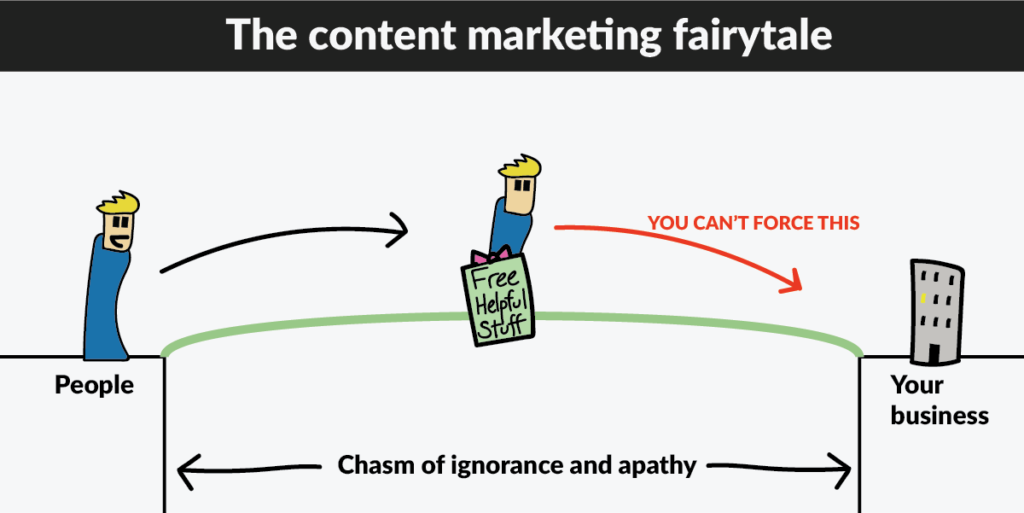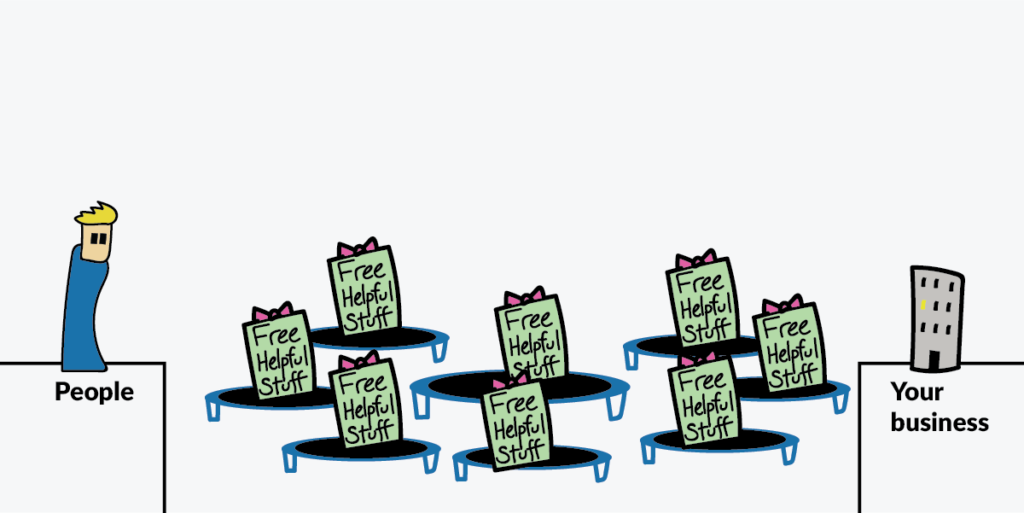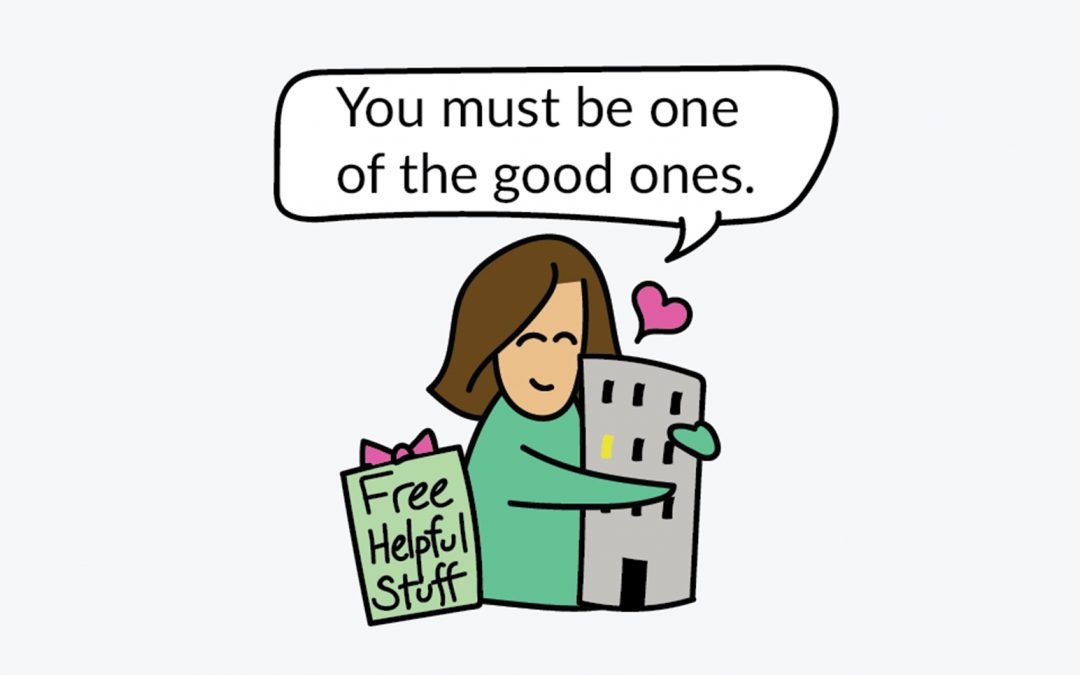Good content marketing is the art and science of helping people make better decisions … and fall in love with your brand along the way. The best content marketers make complex things super simple.
But content marketing itself is a pretty complex concept. When a friend asked one of our team members, “So, what does Overthink do?” it led to a pretty long answer. So she suggested that we make a visual explainer of how the stuff we do works. Great idea, Liz!
So … how does content marketing work?
First, let’s get a high-level overview of what content marketing is.
What is content marketing?
Content marketing is getting business by making Free Helpful Stuff.
In the pre-internet days, marketing was very much vendor-driven. You wanted to buy something? You needed to talk to a salesperson for information—and that information was designed to push you down the sales funnel toward that salesperson’s product.
You couldn’t compare prices and features as easily as you can today. You couldn’t find reviews. And you didn’t have the easiest time educating yourself on the things you were trying to do. That gave marketers a lot more power.

But with the Internet, people have access to a lot more information.
All this has lead to a power reversal: now the buyer has the power. By 2013, Forrester estimated that buyers handled two-thirds to 90% of the traditional sales funnel themselves before ever contacting a salesperson.
If you’re a business owner, you’re thinking, “If the buyer is doing most of the shopping themselves, I need to find a way to get on their radar—and make a good impression!”

Content marketing became a popular way to do this.
Smart marketers said, “We need to earn people’s trust—let’s give them a ton of Free Helpful Stuff to show them that we’re here to help.”

Content = “Free Helpful Stuff”
Content comes in many forms. That might be why content marketers have such a hard time defining “content.”

Kim Moutsos, who’s the VP of editorial at Content Marketing Institute, attempted to define “content” in March of 2018. Kudos to Moutsos: of the content marketing posts I’ve read, I think this may have been the most difficult to write.
Kim gives us her definition, but more importantly notes how there’s not much consensus on what “content” even is.

“Compelling information that informs, engages, or amuses.”
Or, for the sake of this post, Free Helpful Stuff.
It comes in all forms. Blog posts, emails, whitepapers, infographics, even memes. We’ll get into those soon.
Why is content marketing important?
It turns out that content marketing has been a valuable discipline for businesses. When a business does it right, it reaps a host of benefits:
Content marketing earns trust

It’s great when your first impression is giving someone a hand. When you’re making Mutually Helpful Stuff, people meet your brand for the first time as you’re helping them.
Content marketing grows your audience

Everyone loves being the bearer of good news, and that means everyone loves talking about Free Helpful Stuff. It makes them look good when they share it, and it makes you look good, too. By making a lot of Free Helpful Stuff, companies grow their audience—because more people are talking about them.
Both of these tactics are about getting a larger slice of the market pie.
Content marketing generates demand
But content marketing can also grow the whole pie.

Making broad-reaching content can raise awareness for your brand in a way that brings more people into your market.
Free Helpful Stuff is a powerful thing.
Low cost per acquisition

In the long run, it tends to be less expensive to acquire customers via content than it is to acquire them via more traditional means.
That’s because Free Helpful Stuff warms them up to you. It sets you up as an irresistible choice by the time people are making a purchasing decision.
So how does content marketing work?
There are two ways to answer this. One answer is the fairytale version—the other is a little more reflective of real life, but a lot less romantic.
Both are true … to an extent.

We recognize that there’s a chasm of ignorance and apathy between us and our market. People don’t care about us. Maybe they don’t know about us. Maybe they don’t know much about our product category either.
We need to help them cross that gap—preferrably in a way that educates them and makes them desire our products.
In a sense, content marketers build bridges between people and our products using Free Helpful Stuff.

This isn’t untrue. It’s just a little simplistic.
In real life, it’s not so linear.
This fairytale sums up how content marketing works at a high level. But if you’re going to build a robust content marketing strategy, you’ll need to understand the not-so-romantic, not-so linear realities.
The unromantic truth
Customers don’t follow a straight line. They’re the ones with the power here, so they get to write their own stories. You can’t expect them to follow your funnel—all you can do is lay out all the good, Free Helpful Stuff you can.
The customer’s in control. You can’t determine what they’ll do after they get your Free Helpful Stuff.
They might immediately love you and purchase from you. They might forget all about you. They might wait for a few years before they make a purchasing decision (like I did before finally pulling the trigger on Ahrefs).
Which means in real life, Free Helpful Stuff looks less like a bridge and more like a trampoline.
So how do companies deal with this?
They give the market more trampolines to land on.
The companies committed to content marketing tend to build libraries of ebooks, blog posts, cheat sheets, case studies, etc. Instead of relying on a single piece of content turning a stranger into a customer, they give people plenty of opportunities to get more Free Helpful Stuff—and therefore, more opportunities to fall in love with the brand.

So, what kind of Free Helpful Stuff can a company make? That’s a huge question. And I want to publish the Internet’s best answer to it … later this year. =)
But for the time being, you can know that companies make all sorts of Free Helpful Stuff in many different ways:
- Some companies write Free Helpful Stuff:
- Blogging
- Whitepapers
- Some companies design Free Helpful Stuff:
- Infographics
- Slide decks
- Charts
- Some companies film Free Helpful Stuff:
- Explainers
- Webinars
- Tutorials
- Some companies record and broadcast Free Helpful Stuff:
- Podcasts
- Audiobooks
- Some companies code Free Helpful Stuff:
- Tools
- Interactives
- Some companies even print Free Helpful Stuff:
- Magazines
- Books
Content marketing is like skinning cats: there’s more than one way to do it. Content marketing is very unlike skinning cats in that content marketing is a wonderful practice but skinning cats is just terrible.
But how do people learn about Free Helpful Stuff?
There’s one piece of the content marketing mechanics we haven’t tackled yet: how people find out about Free Helpful Stuff.

As you can imagine, there are all kinds of ways people might hear about a piece of Free Helpful Stuff. But most of these avenues fall under one of three categories: earned media, paid media, and owned media.
Owned media

Owned media is the kind of promotion you can do yourself within your own ecosystem. A company can promote content by emailing their list of users, or by the CEO tweeting the latest infographic. They already own the channels, so they can tell people about their content all they want.
Smart companies don’t overdo it.
Some examples of owned media channels:
- Company website and blog
- Company and employee social profiles
Paid media

Paid media’s pretty straightforward too: you pay to get coverage. This could be sponsored media on another channel, or just buying ads pointing to your content.
Examples of paid media channels:
- Facebook ads
- Remarketing ads
- SEM ads
- Sponsored content
Earned media

Earned media is what you get when you do something so noteworthy that other people talk about you. It’s the stuff that gets picked up by big websites and journalists. It’s the stuff that gets linked to from other blogs. It goes viral. The kind of content that everyone can’t help but talk about results in a lot of earned media.
Examples of earned media channels:
- Speaking opportunities
- News coverage
- Guest posts
- Podcast interviews
These aren’t mutually exclusive. Most companies that can do all three, do all three.

Conclusion
There you have it, folks. An entire multi-disciplinary practice boiled down to about 1,500 words and 17 doodles.
Content marketing is doing business by making Free Helpful Stuff, because the customer is in charge now. By earning their trust, you earn their business. That’s how content marketing works.
Market strategically, friends!



Thank you for this!!!